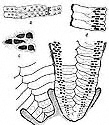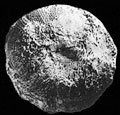The Echinoid Directory
Kierechinus Philip, 1963, p. 1104
| Diagnostic Features |
|
|---|---|
| Distribution | Early Eocene (Ypresian), Somalia. |
| Name gender | masculine |
| Type | Pedinopsis melo Kier, 1957, by original designation. Holotype (now lost) Sedgwick Museum, Cambridge C3007. |
| Species Included |
|
| Classification and/or Status |
|
| Remarks |
|


